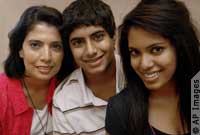DIVERSITY | Offering a place for everyone
07 July 2008
A Teenager’s View of Islam in America
Young people explain what it means to be an American Muslim

Washington -- Of all the faiths practiced in the United States, Islam is the fastest growing, the most questioned and the least understood.
“Will you wear Muslim clothes to school tomorrow?” “When we go to your house can we eat Muslim food?” “Do you know where Osama bin Laden is?”
These are some of the questions that young American Muslims are faced with from their non-Muslim peers in the post-9/11 era.
The Hafiz family -- Imran, 16, Yasmine, 18, and their mother, Dilara -- wrote The American Muslim Teenager’s Handbook in 2007 to begin to shed some light on many of these questions and to provide a resource to other young Muslims trying to balance the American culture with their religion.
“There were lots of resources for Christians and Jews, but it is good to have resources for Muslims,” Yasmine said.
She saw a need to provide American Muslims teenagers like herself with a guide to help them better understand their religion and how to be a good Muslim.
Both Yasmine and Imran encountered stereotypes at their school, such as that all Muslims share the same dress, food and rituals. They wrote this book to show that Islam is a religion and not connected to a specific culture of its own.
Those who practice Islam are just as diverse as Americans who practice any other faith. Muslims come from a variety of countries, speak many different languages, and have different cultures. To the Hafiz family there is no one way to be a Muslim, and this is what they emphasize in their book.
Their book stresses the basics, or the “fundamentals” as Imran puts it, of Islam. It talks to people who are new to the faith and want to learn more, and it provides how-to instructions for young Muslims who may be unclear about all the nuances of their faith.
The book is written in approachable and accepting language. It does not try to convert anyone to the religion, nor does it admonish those who are more secular in practicing their faith and do not strictly follow every rule.
It explains why Muslims pray five times a day, what the pillars of the faith are, who Mohammed was and how to fast. It probes more controversial issues about what Muslims can eat, wearing the hijab and what every teenager wants to know about dancing, drinking and dating.
Since there is no single head of Islam, American Muslims lacked a unified authority to address the public’s fear of Islam after the September 11, 2001, terrorist attacks.
“We sensed a trend in alienation,” Dilara said.
The family said they saw Muslims who were more secular begin to turn away from the faith, and they also saw Muslims become more conservative or radicalized in response to the tension regarding Islam in America.
“Why not define ourselves,” said Yasmine about being an American Muslim during this time.
The family also discussed how the attacks made Muslims abroad fearful of coming to America. The family said they want to enlighten others about Islam, but also let Muslims abroad know that America is not a bad place for Muslims.
“People abroad say, ‘Wow, you live in America as a Muslim and it’s okay,’” Dilara said.
“The way terrorism is fought is through education. Promoting this is our ‘jihad,’” Imram said.
The handbook is available in 600 libraries.
Also see Education.
